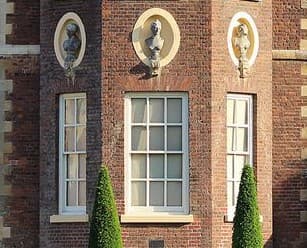Box Sash Window
Contact us
Box Sash Windows.
The term ‘sash’ originates from the French word chassis meaning frame — potentially an odd name for a window renowned as a quintessentially British. Constructed in the Georgian Era, box sash windows have withstood the test of time. And most still in-situ today are subject to restoration laws to preserve their historic heritage.


15-16th Century box frame and sashes
During the Stuart and Georgian Eras the majority of households could not afford glazing, which saw most windows created from sliding or folding wooden shutters. With only the wealthiest homes being able to afford glass, glazed windows were a symbol of the family’s social status. These first paned windows were known as casement windows and were hinged at the sides, inward opening, and supported by leaded criss-cross glazing.
17th Century box frame and sashes
Glass became easier to access during the Georgian Era, which saw an increased number of households able to afford paned windows. Due to this, larger sash-style windows began to replace the small, dark casement windows of the 16th century. These larger windows offered a brighter and more insulated alternative — with no shutters or doors to affect the outer look of the property. It is not known where or how the sash window was designed. It’s been suggested the creation was that of Robert Hooke, a prominent architect in London at the time. But they are also recognised as a European invention, founded by the Dutch. Sash windows were a prominent feature in grand homes by the Stuart Era. And the earliest known use of sash came at the latter part of the 17th Century, which saw them installed in Chatsworth House, Ham House, Hampton Court Palace, and Kensington Palace. The status symbol of the sash window was further elevated by the window tax of 1695. The government imposed a heavy tax, resulting in architects building properties with fewer windows and bricking up those with ‘too many’; it’s thought this is where the expression ’daylight robbery’ originates.
Great Fire of London -1666
Alterations to the original sash window design were imposed during the 17th Century, following research into the causes of the Great Fire of London in 1666. The research attributed wooden windows as a major factor in the spread of the fire. Starting at a bakery in Pudding Lane, the fire spread across the city resulting in the loss of 70,000 out of the city’s 80,000 homes. After the disaster in 1709, the government passed a building act which ruled it no longer regulation to build windows with exposed timber flush to the brick wall. Instead, windows were to be set back four inches from the opening; this new style of sash was dubbed ‘recessed box sash’.
Box sash Vs French Window – 18-19th Century
Box sash windows continued in popularity throughout the 18th and 19th Centuries. During the Regency Period and into the Victorian, architects experimented with the style of the windows. Victorian sash windows presented a gothic theme, using long thin panes, pointed arches, and coloured glass.
The size of window-to-wealth ratio continued, and sash window desirability dropped. Instead French windows became popular, with many homes replacing their sash windows with the fashionable, European design.
Box sash Vs French Window – 18-19th Century
Box sash windows continued in popularity throughout the 18th and 19th Centuries. During the Regency Period and into the Victorian, architects experimented with the style of the windows. Victorian sash windows presented a gothic theme, using long thin panes, pointed arches, and coloured glass.
The size of window-to-wealth ratio continued, and sash window desirability dropped. Instead French windows became popular, with many homes replacing their sash windows with the fashionable, European design.

20th Century Box
The end of WW2 saw the abandonment of almost all sash windows. They lost out in favour of simple ‘storm proof’ designs featuring large, single panes of glass — which were modern and less expensive. Fast forward to the present day and almost 75 percent of original sash windows have disappeared due to demolition or modernisation. In reality the value, architectural integrity, and beauty of a home can be preserved with well-maintained or restored timber windows; thus preserving the British heritage of our older homes.
